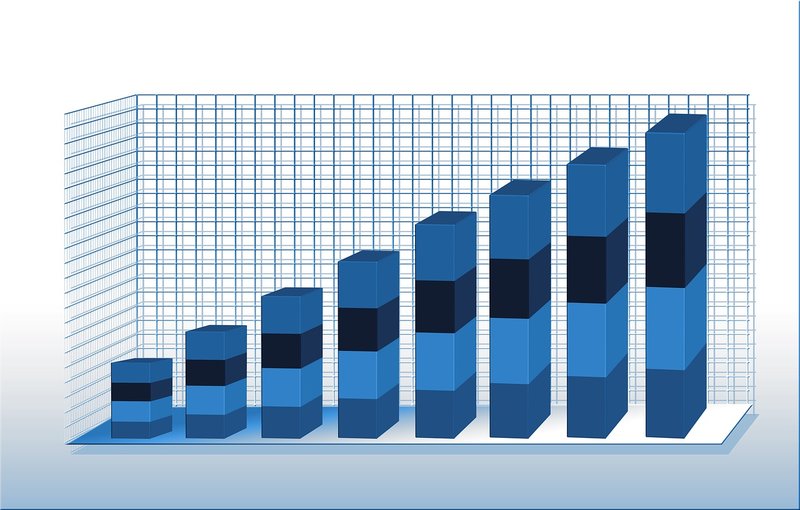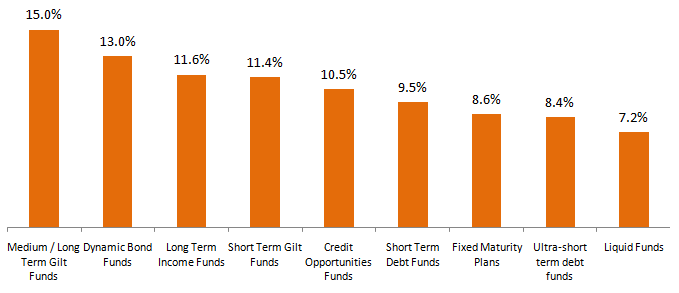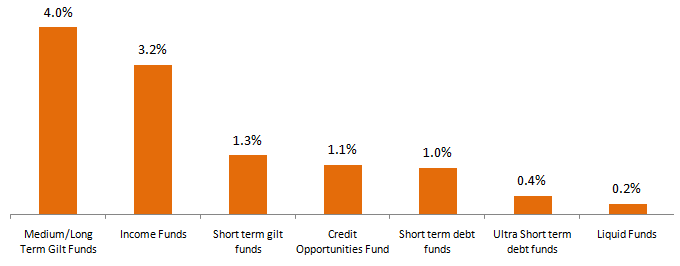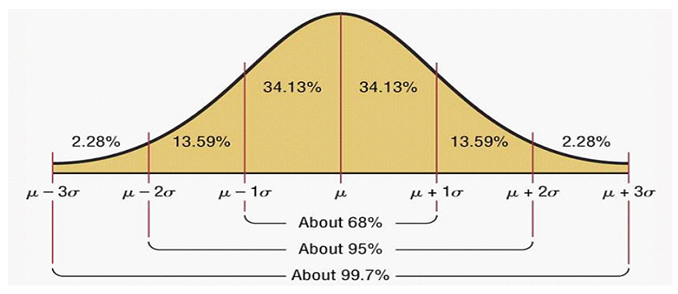Why you should not ignore Debt Mutual Funds

In 2015 and 2016 year to date debt mutual funds on an average have outperformed equity mutual funds. Investors with a long term investment horizon should not be concerned with equity underperformance over the last 2 years because, as discussed a number of times before in our blog, historical data shows that, equity is the best performing asset class in the long term. Over various short to medium term investment horizons, debt funds provide great solutions for a variety of investment needs across different investment tenures (ranging from a few days to many years), risk appetites and interest rate scenarios. For many years, the narrative about debt mutual fund mostly stressed on the tax advantage compared to traditional debt products and since the tax advantage (for investment terms of less than 3 years), it was thought the debt funds would lose their attractiveness. The reality is opposite. But as per AMFI October 2016 report, the share of debt funds in mutual fund industry Assets under Management (AUM) is up on a year on year basis. The vast majority of debt fund AUM is accounted for by institutional investors, but retail interest in debt fund is also increasing.
Debt mutual funds have given excellent returns
Many bloggers and media persons wrote the obituary of debt funds after the 2014 Budget of the NDA Government. They were simply focusing on the taxation aspect and ignoring risk / return characteristics of debt fund versus risk free investments (like fixed deposits, small savings schemes etc). Historical data shows that, debt funds can give investors significantly higher returns compared to bank fixed deposits and even small savings schemes. The chart below shows the average returns of various debt fund categories (including money market mutual funds) in the last one year (some of the numbers may surprise you).

Source: Advisorkhoj Mutual Fund Category Monitor
You can see that, average returns of all debt mutual fund categories was considerably higher than what you would have got from risk free debt products (bank and small savings) in the last one year. Bank FD interest rates are around 7 to 7.5%; small savings interest rates are around 8%. You can see that, debt fund category returns ranged from 8.6% (for FMPs) to 15% (for long term gilt funds). Many debt fund categories gave double digit returns; remember we are referring to average category returns and individual debt fund schemes would have given higher returns than the average category returns. If you want to see debt fund category returns over different time-frames, please use our tool Mutual Fund Category Monitor.
If you compare the returns of money market mutual funds like liquid funds and ultra-short term debt funds with your savings bank account interest rate, you will realize that you are losing a lot of income by having large amounts sitting idle in your savings bank account. Money market mutual funds are highly liquid and very low risk investments with no exit load; in other words, you can draw your money at any time from these funds without any penalty and receive the funds in your bank account within 24 hours on business days. Some fund houses offer instant (within a few minutes) redemption facilities for liquid funds. The returns of these funds versus your savings bank interest make them compelling options for parking very short term funds.
Why do debt funds usually give higher returns than Bank FD
The returns of debt funds make them compelling investment choices versus bank FDs and small savings schemes, but some investors may ask, as we say here in India, what is the catch? In my opinion, it is the right question to ask, because as famous economist, Milton Friedman said, there is no free lunch. You should understand the investment characteristics of a product before investing. Bank FDs are risk free products, whereas debt mutual funds are not. If the investor takes a risk, he or she is usually rewarded with higher returns.
The risk return relationship is a fundamental and fairly easy to understand concept; the problem with many investors due to lack of financial education in India, is a good understanding of risk. I have heard many investors ask, “Is there risk in this investment”? If they expect a “yes / no” answer, which I suspect many do, they are treating risk as binary. However, risk is not binary; there are many grades of risk. SEBI has several risk category grades for mutual funds, including debt funds. We will discuss risk later in this post, but the behavioural aspect of investing should also be discussed. To get superior results from their investments, investors need to change their mindset from assured returns to market returns with proper risk evaluation.
Debt and money market securities like bonds, CP / CDs etc can give higher returns than risk free investments because they offer higher yields than risk free investments (why would anyone buy these papers, if they offered less than risk free returns). In addition to higher yields, since these papers are traded in the market, their prices appreciate with fall in interest rates or improvement in credit rating (in case of corporate bonds). On the flipside, the price of these papers may fall if the conditions are reversed. That is why we say that, debt funds are subject to market risks and it is important to get a good understanding of the risk, which is the subject of our next section.
Risk of debt funds
In Advisorkhoj we follow a data driven analytical approach, because an analytical approach can clarify misunderstandings caused by perceptions. We will discuss the risk of debt funds from an analytical viewpoint and explain how you can use a good understanding of risk in making smart investment decisions. In finance as common measure of risk is standard deviation, more commonly known as volatility (though from a strict technical standpoint, volatility and standard deviation are slightly different). The chart below shows the volatility (standard deviation) of different debt fund categories.

Source: Advisorkhoj Research
You can see that the average volatilities (standard deviations) of different open-ended debt fund categories range from 1 – 4%. Just to put the volatility of debt funds in perspective of the risk spectrum across different asset categories, we would like to point out that, average volatilities of large cap equity funds was 14%, while that of mid cap equity funds was 17%. For investors who think of risk in binary terms, surely 17% is not same as 4%. The average of volatilities of money market mutual funds (liquid and ultra short term debt funds) range from 0.2 – 0.4%. Just from volatility numbers, you can get a sense that, these are very low risk investments.
How you can use risk (volatility) to make smart investment decisions
Our regular blog readers know that, risk and return are directly related. What investors struggle with is, determining how much risk they can afford and how to make investment decisions in an objective way. A good understanding of the statistical framework of volatility (standard deviation) can help you make optimal investment decisions. The bell curve or normal distribution helps investors evaluate risk of investment in relationship to returns.

Here μ is the average returns and σ is the standard deviation. The bell curve tells us that, probability of getting returns higher than Average – Standard Deviation is 84%. The probability of getting returns higher than Average – 2 X Standard Deviation is 98%. If the average returns of a debt fund category is 10% and the standard deviation is 1% then there is an 84% chance that you will get more than 9% returns and a 98% chance that you will get more than 8% returns. If you think that, the average returns of a fund is skewed by interest rate movements (either rising or falling) during the period in consideration, you should look at the returns over a longer period which includes both rising and falling interest rates. You can look up returns of debt funds and debt fund categories over different investment periods by going to our MF Research section.
Mix of different debt funds in your portfolio
Different debt fund categories have different risk / return characteristics. The long term debt funds are more sensitive to interest rate changes, while short term debt funds are less sensitive to interest rate changes. Credit opportunities funds (corporate bond funds) can give you a few percentage points of extra yield by investing in slightly lower rated papers.
Financial planners recommend that, investors should have a mix of different debt funds in your portfolio. You can have a mix of 50% long term debt funds (e.g. long term gilt funds, income funds, dynamic bond funds etc) and 50% short term debt funds (e.g. short term gilt funds, short term debt funds, credit opportunities funds), or a mix of 60% long term debt funds and 40% short term debt funds or any other mix, depending on your own investment needs.
Conclusion
In this post, we have discussed that debt funds gave excellent returns in the last one year, during a period of considerable uncertainty in the global economy and capital markets. Many economists believe that, the demonetization move by the Government will improve the liquidity situation in the banking system and we may see reduction in interest rates next year. However, there are risk factors associated with US interest rates and the trajectory of crude prices. Having said as discussed earlier, debt funds offer solutions for different interest rate scenarios because different debt fund categories have different risk / return sensitivity to interest rates. We discussed a statistical framework of debt mutual fund risks, so that you have a quantitative understanding of risk and return in order to make the best investment decision.
Mutual Fund Investments are subject to market risk, read all scheme related documents carefully.
RECOMMENDED READS
LATEST ARTICLES
- Why you need to have hybrid mutual funds in your portfolio: Different types of funds Part 2
- Why you need to have hybrid mutual funds in your portfolio: Misconceptions Part 1
- Which is the best time to invest in mutual funds
- Economic slowdown: Is it real and what should you do
- Importance of liquidity in investing: Mutual funds are ideal solutions
An Investor Education Initiative by ICICI Prudential Mutual Fund to help you make informed investment decisions.
Quick Links
Follow ICICI Pru MF
More About ICICI Pru MF
POST A QUERY




